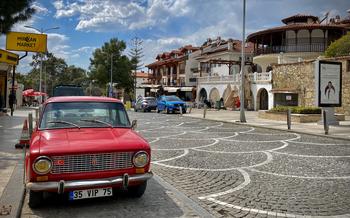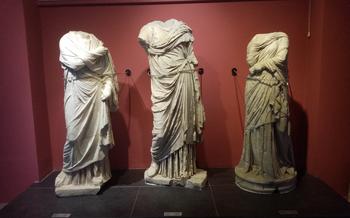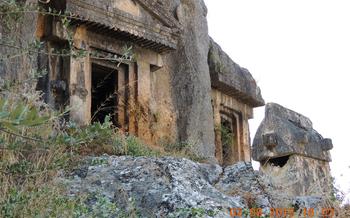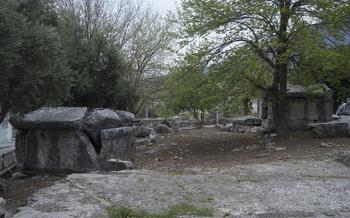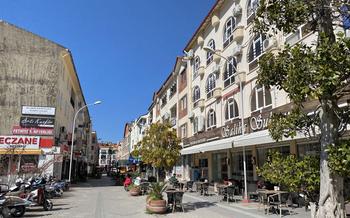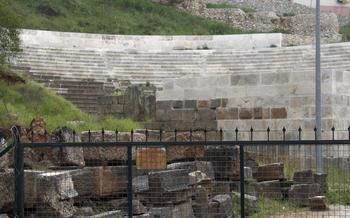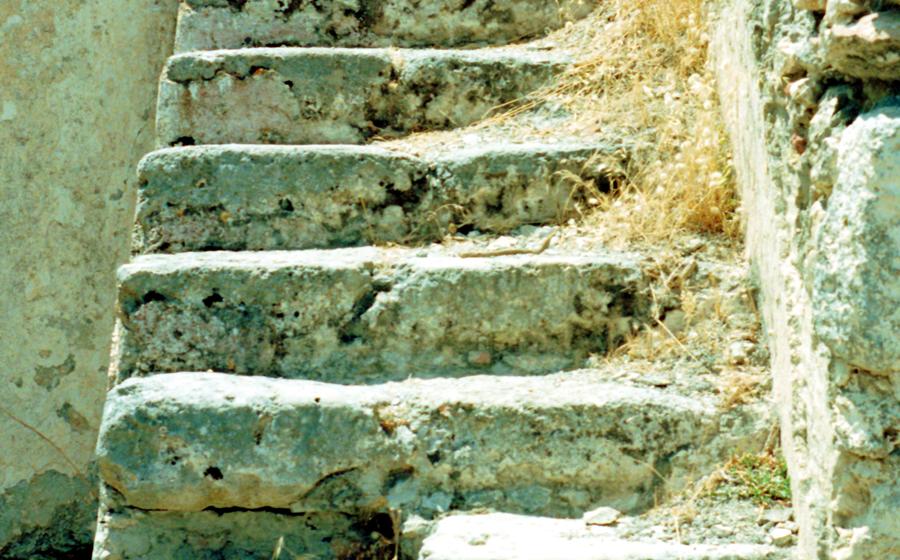
Fethiye Museum
- Historical Overview
- Location and Accessibility
- Museum Hours and Admission Fees
- Exhibits and Collections
- Archaeological Treasures
- Ethnographic Displays
- Interactive Experiences
- Temporary Exhibitions
- Guided Tours
- Museum Shop and Souvenirs
- Accessibility for Visitors with Disabilities
- Educational Programs and Workshops
- Photography and Videography Policies
- Nearby Attractions and Activities
- Insider Tip
Historical Overview
The Fethiye Museum stands as a testament to the rich history and cultural heritage of Fethiye, a captivating town nestled along Turkey's breathtaking Turquoise Coast. Once known as Telmessos, Fethiye served as a significant port city during ancient times, leaving behind a legacy of intriguing ruins and artifacts. The museum, established in 1987, is housed within a beautifully restored Ottoman-era building, providing a glimpse into the region's fascinating past.
Notion: Archaeological and historical context of the region. The Fethiye Museum's collection offers a comprehensive insight into the archaeological and historical significance of the region. Fethiye's strategic location at the crossroads of ancient civilizations, including the Lycians, Romans, Byzantines, and Ottomans, has resulted in a diverse tapestry of cultural influences reflected in the museum's exhibits.
Suggestion: Visiting the museum as part of a historical tour of Fethiye. To fully appreciate the historical context of the Fethiye Museum, consider embarking on a historical tour of Fethiye. Explore the ancient ruins, such as the Lycian rock tombs and the Fethiye Castle, and uncover the captivating stories that shaped this captivating town.
Anecdote: A personal story or local legend related to the museum or its collection. During my visit to the Fethiye Museum, I stumbled upon a captivating local legend associated with a peculiar artifact. According to the tale, a mysterious statue unearthed during an excavation possessed the power to grant wishes. Intrigued, I couldn't resist making a wish, hoping to unravel the secrets of this enchanting town.
Location and Accessibility
The Fethiye Museum is strategically located in the heart of Fethiye, making it easily accessible for visitors. Situated on Atatürk Caddesi, the museum is a short walk from the vibrant city center and its bustling harbor. To reach the museum, visitors can take advantage of the convenient public transportation options available in Fethiye. The dolmuş, a shared minibus system, offers multiple routes that stop near the museum, providing an affordable and accessible mode of transport. Additionally, visitors can opt for the Fethiye Belediyesi Otobüsleri, the city's bus network, which also has designated stops close to the museum. For those who prefer a more personalized experience, taxis are readily available in Fethiye and can be hailed from the street or arranged through local transportation services. Whether exploring the city's historical treasures or simply enjoying a leisurely stroll, the Fethiye Museum is conveniently positioned for visitors to delve into the rich cultural heritage of this captivating region.
Museum Hours and Admission Fees
The Fethiye Museum is open to visitors seven days a week, from 8:30 AM to 5:30 PM. Plan your visit accordingly to avoid disappointment, as the museum may be closed on certain holidays or for special events.
Admission Fees: - Regular Admission: 80 TL per person - Student Admission: 40 TL per person (with valid student ID) - Children under 6: Free admission
Tips: - Beat the Crowds: Aim to visit the museum early in the morning or late in the afternoon to avoid the peak tourist crowds. - Combo Tickets: Consider purchasing a combined ticket that includes admission to multiple museums and attractions in Fethiye for a discounted rate. - Photography: Photography is permitted inside the museum, but using a flash or tripod is not allowed.
Exhibits and Collections
The Fethiye Museum houses a diverse collection of artifacts that span different eras and civilizations. These exhibits provide a glimpse into the rich history and cultural heritage of the region.
Notion: Thematic and chronological organization of the exhibits.
The museum's exhibits are organized thematically and chronologically, allowing visitors to trace the development of human civilization in the region. One section focuses on the ancient city of Telmessos, with artifacts from the Lycian, Roman, and Byzantine periods. Another section showcases the rich Islamic heritage of the region, with exhibits on the Ottoman Empire and the Seljuk Turks.
Suggestion: Highlights of must-see artifacts or sections of the museum.
Among the must-see artifacts in the museum are the Lycian sarcophagi, which are elaborately carved stone coffins dating back to the 4th century BC. The museum also houses a collection of ancient coins, pottery, jewelry, and sculptures that provide valuable insights into the daily lives and customs of the people who inhabited the region.
Anecdote: A personal anecdote about a favorite exhibit or object in the museum.
My personal favorite exhibit in the Fethiye Museum is the statue of the "Weeping Woman." This beautiful marble sculpture depicts a woman with tears streaming down her face. It is believed to date back to the Hellenistic period and is thought to represent the grief of a mother who has lost her child. The statue's lifelike expression and intricate details never fail to move me.
Archaeological Treasures
The Fethiye Museum is a treasure trove of archaeological wonders that shed light on the rich history and cultural heritage of the region. Among the must-see artifacts is the impressive collection of Lycian sarcophagi, intricately carved with scenes from mythology and daily life. These elaborate stone coffins offer a glimpse into the beliefs and customs of the ancient Lycians, who inhabited this region in antiquity.
Another highlight of the museum is the collection of ancient Greek and Roman sculptures, including stunning marble statues and busts. These works of art showcase the artistic prowess of the region's former inhabitants, demonstrating their mastery of form and detail.
One of the most significant artifacts in the museum is the "Trilingual Stele" of Letoon, dating back to the 4th century BC. This remarkable stone tablet features inscriptions in Greek, Lycian, and Aramaic, providing valuable insights into the languages and cultures of the ancient world.
The museum also houses a vast collection of ceramics, coins, jewelry, and other artifacts that tell the story of Fethiye's rich past. These objects offer a tangible connection to the people who lived here centuries ago, allowing visitors to appreciate the continuity and evolution of human civilization in this region.
Ethnographic Displays
The Fethiye Museum also houses a rich collection of ethnographic artifacts that provide a glimpse into the local culture and traditions of the region. These exhibits showcase traditional clothing, jewelry, household items, and tools, offering visitors a deeper understanding of the daily life and customs of the people who have inhabited this area throughout history.
Notion: Preserving and showcasing cultural heritage.
The ethnographic displays at the Fethiye Museum play a crucial role in preserving and showcasing the cultural heritage of the region. They help to keep alive the traditions and customs of the local people, ensuring that they are not lost or forgotten.
Suggestion: Tips for understanding and appreciating the ethnographic displays.
To fully appreciate the ethnographic displays at the Fethiye Museum, it is helpful to have some background knowledge of the local culture and history. Visitors can enhance their understanding by reading the informative labels accompanying each exhibit or by taking a guided tour with a knowledgeable guide who can provide additional insights and explanations.
Anecdote: A personal experience or observation related to the local culture.
During my visit to the Fethiye Museum, I was particularly struck by a display of traditional Turkish carpets. The intricate designs and vibrant colors were simply breathtaking. I learned that carpet weaving is a highly valued skill in the region, and that each carpet tells a unique story about the family or community that created it. It was a truly special experience to see these beautiful and meaningful works of art up close.
Interactive Experiences
The Fethiye Museum offers a range of interactive exhibits and activities that bring history and culture to life for visitors of all ages. One of the highlights is the virtual reality (VR) experience, which allows visitors to step back in time and explore ancient Fethiye as it once was. Put on a VR headset and immerse yourself in a realistic and engaging virtual world, where you can wander through the streets, visit historical landmarks, and interact with virtual characters.
Another popular interactive exhibit is the touchscreen display, which features a collection of high-resolution images and videos of artifacts from the museum's collection. Visitors can zoom in on the images, rotate objects in 3D, and learn more about their history and significance.
For a hands-on experience, head to the interactive archaeology station, where you can try your hand at excavating artifacts from a simulated archaeological site. Using tools like brushes and trowels, you can uncover ancient pottery, coins, and other objects, just like a real archaeologist.
These interactive exhibits not only enhance the visitor experience but also make learning about history and culture more fun and engaging, especially for younger visitors. So, be sure to include them in your itinerary when visiting the Fethiye Museum.
Temporary Exhibitions
The Fethiye Museum is committed to keeping its offerings fresh and exciting by hosting temporary or rotating exhibitions alongside its permanent collection. These exhibitions often focus on specific themes, historical periods, or artistic movements related to the region and its rich history. They provide an opportunity for visitors to delve deeper into the local culture and heritage while showcasing new and unique perspectives.
To stay informed about upcoming temporary exhibitions, visitors can check the museum's official website or follow its social media channels. These platforms provide regular updates on current and upcoming exhibitions, along with details on their themes, duration, and any special events or programs associated with them.
One particularly memorable temporary exhibition at the Fethiye Museum was "Treasures of the Lycian Coast," which showcased a stunning collection of artifacts from ancient Lycian cities such as Patara, Xanthos, and Letoon. The exhibition featured intricate sculptures, ornate jewelry, and finely crafted pottery, offering visitors a glimpse into the artistry and craftsmanship of this ancient civilization.
By presenting temporary exhibitions, the Fethiye Museum strives to provide a dynamic and engaging experience for its visitors, allowing them to explore new aspects of the region's history and culture with each visit.
Guided Tours
The Fethiye Museum offers guided tours in various languages to enhance visitors' experiences and provide deeper insights into the exhibits. These tours are conducted by knowledgeable and experienced guides who can bring the museum's collection to life and share fascinating stories and historical context.
Suggestion:
Book a guided tour in advance, especially during peak season, to secure a spot and avoid disappointment. Choose a tour that matches your interests and language preferences.
Anecdote:
During my visit to the museum, I had the pleasure of joining a guided tour led by an enthusiastic and well-informed guide named Ayşe. Her passion for history and archaeology was contagious, and she brought the exhibits to life with her vivid descriptions and engaging storytelling. Ayşe's insights enriched my understanding of the museum's collection and made the visit even more memorable.
Museum Shop and Souvenirs
The Fethiye Museum offers a well-stocked museum shop where visitors can purchase a variety of souvenirs to commemorate their visit and support the museum's ongoing efforts. From postcards and magnets featuring images of the museum's most iconic artifacts to replicas of ancient coins and jewelry, there is something for every budget and taste.
Notion: Supporting the museum and taking a piece of history home.
By purchasing a souvenir from the museum shop, visitors not only take home a tangible reminder of their visit but also contribute to the museum's continued operation and preservation of its valuable collection. The revenue generated from souvenir sales helps to fund educational programs, conservation projects, and new acquisitions, ensuring that the museum remains a vibrant and dynamic institution for years to come.
Suggestion: Tips for finding unique and meaningful souvenirs.
When browsing the museum shop, take the time to look beyond the standard tourist fare and seek out unique and meaningful souvenirs that reflect the region's rich history and culture. Consider purchasing a handmade ceramic piece inspired by ancient Lycian motifs, a silver pendant adorned with traditional Ottoman designs, or a colorful scarf woven using techniques passed down through generations.
Anecdote: A story about a special souvenir purchased at the museum.
During my visit to the Fethiye Museum, I stumbled upon a beautiful hand-painted ceramic plate depicting a scene from Greek mythology. The intricate details and vibrant colors immediately caught my eye, and I knew I had to have it. As I learned from the museum guide, the plate was a replica of an ancient artifact discovered during excavations at a nearby archaeological site. I was thrilled to be able to take home such a unique and meaningful souvenir, a piece of history that I could cherish for years to come.
Accessibility for Visitors with Disabilities
The Fethiye Museum is committed to providing an inclusive and welcoming environment for all visitors, including those with disabilities. The museum features a number of accessibility features to ensure that everyone can enjoy the exhibits and learn about the region's rich history and culture.
Wheelchair Accessibility: The museum is wheelchair accessible, with ramps and elevators providing easy access to all levels of the building. Wide doorways and accessible restrooms further ensure that visitors with mobility impairments can navigate the museum comfortably.
Audio Guides and Descriptive Signage: For visitors who are blind or visually impaired, the museum offers audio guides that provide detailed descriptions of the exhibits. Descriptive signage is also available throughout the museum, allowing visitors to learn about the artifacts and their significance without having to rely on their sight.
Accessible Tours: The museum offers guided tours that are tailored to the needs of visitors with disabilities. These tours can be customized to accommodate specific requirements, such as slower pacing, sign language interpretation, or the use of assistive devices.
Staff Training: The museum staff is trained to be sensitive to the needs of visitors with disabilities and to provide assistance as needed. They can help with everything from providing directions to finding accessible restrooms or offering assistance with the audio guides.
Tips for Visitors with Disabilities:
- When planning your visit, be sure to let the museum staff know about any specific needs or accommodations you may require.
- If you have any questions or concerns, don't hesitate to ask a member of the museum staff for assistance.
- Take advantage of the museum's accessible features, such as ramps, elevators, audio guides, and descriptive signage.
- If you have a disability that requires additional assistance, such as a sign language interpreter or a personal assistant, be sure to bring them with you.
Educational Programs and Workshops
The Fethiye Museum offers a range of educational programs and workshops designed to engage visitors of all ages and backgrounds. These programs provide an opportunity to delve deeper into the history, culture, and archaeology of the region, fostering learning and hands-on experiences beyond the exhibits.
Notion: Fostering Learning and Engagement Beyond the Exhibits
The museum's educational programs are carefully curated to cater to diverse interests and learning styles. They aim to create a dynamic and interactive environment where visitors can explore the museum's collection, participate in hands-on activities, and gain a deeper understanding of the region's rich cultural heritage.
Suggestion: Tips for Finding Out About Upcoming Programs and Workshops
To ensure you don't miss out on these enriching experiences, it's advisable to check the museum's website or social media pages for information on upcoming programs and workshops. Advance booking is recommended to secure your spot, especially for popular or limited-size programs.
Anecdote: A Story About a Particularly Impactful Educational Experience at the Museum
During my visit to the Fethiye Museum, I had the opportunity to participate in an interactive workshop on ancient pottery. Under the guidance of a skilled artisan, we learned about the techniques and materials used in traditional pottery making. The hands-on experience of molding and decorating our own clay pots was not only enjoyable but also provided a deeper appreciation for the craftsmanship and artistry of ancient potters.
Photography and Videography Policies
The Fethiye Museum welcomes photography and videography for personal use, but there are a few guidelines to keep in mind. Flash photography is not permitted, as it can damage the delicate artifacts. Tripods and selfie sticks are also not allowed, as they can obstruct the flow of visitors. Visitors are encouraged to take photos and videos to capture their memories, but they should be mindful of other visitors and the museum's collection.
Anecdote:
On my last visit to the museum, I noticed a young couple trying to take a selfie with a flash. A museum guard politely approached them and explained the museum's photography policy. The couple was apologetic and thanked the guard for the information. They then took a few photos without flash and were able to capture their memories without disturbing anyone.
Nearby Attractions and Activities
The Fethiye Museum is situated in the heart of a vibrant and historically rich region, offering visitors a wealth of other attractions and activities to explore. Just a short stroll from the museum, you can discover the ancient ruins of Telmessos, once a prosperous city-state that rivaled Rhodes. Explore the remnants of its impressive walls, temples, and theaters, and immerse yourself in the fascinating history of this ancient civilization.
For nature enthusiasts, the stunning Oludeniz Beach is a must-visit. With its crystal-clear waters, white sandy shores, and dramatic mountain backdrop, it's a paradise for swimming, sunbathing, and water sports. Take a refreshing dip in the turquoise sea, soak up the sun's rays, or embark on a thrilling paragliding adventure, offering breathtaking views of the coastline.
If you're looking for a unique cultural experience, head to the vibrant Fethiye Market. This bustling bazaar offers an array of local delicacies, handmade crafts, and souvenirs, providing a glimpse into the region's rich traditions and vibrant lifestyle. Haggle with friendly vendors, savor the flavors of Turkish cuisine, and take home a piece of Fethiye's charm.
For a serene escape, venture to the Saklikent Gorge, a natural wonder located just a short drive from Fethiye. Hike through the narrow canyon, marvel at the towering rock formations, and take a refreshing dip in the cool waters of the river that flows through the gorge. Enjoy a peaceful picnic surrounded by stunning scenery, and create lasting memories in this breathtaking natural setting.
Insider Tip
One of the best ways to experience the Fethiye Museum is to visit during the annual Fethiye Culture and Art Festival. Held in July or August, the festival brings the museum to life with traditional music and dance performances, art exhibitions, and workshops. It's a fantastic opportunity to immerse yourself in the local culture and history while exploring the museum's collection.
As a bonus tip, keep an eye out for the museum's "curator's choice" exhibit. This special display showcases some of the most unique and fascinating artifacts from the museum's collection, providing a glimpse into the hidden treasures that lie beneath the surface of this remarkable institution.
